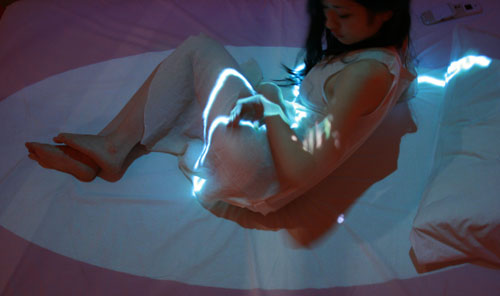Long Distance and Intimacy (Response Is the Medium)

Myron Krueger recognized the “sense of being together” that can be achieved through a phone conversation, but lamented that neither sight nor touch are possible through the telephone.
In 1975 he developed the VIDEOPLACE experiment that allowed two people in separate locations the ability to communicate with each other using graphical shadow representations of their bodies that were being projected onto large screens in each location. With VIDEOPLACE he noticed the level of intimacy two humans can exchange just by interacting with a live image of another’s body: “What happens to his image happens to him. In fact,when one person’s image overlaps another’s, there is a psychological sensation akin to touch.”
Over the past decade, distant lovers have been offered an array of new ways to connect: email, SMS, live video chat and even through ambient intimacy (the idea of staying attuned to someone else’s life through frequent status updating). Yet, among all these new communication tools there isn’t a popular system that can transmits touch.
Distance Lab is a creative research institute that has been trying “to overcome the disadvantages of distance in learning, health care, relationships, culture and other domains.” Since 2004 they have been working on Mutsugoto, a communication device much like that of Krueger’s VIDEOPLACE, that allows people in different locations to communicate through “the language of touch”. Mutsugoto attempts to create a more intimate bond by allowing a couple to draw on each other’s bodies while lying in separate beds. Distance Labs explains,
“A computer vision system tracks the movement of the ring and projects virtual pen strokes on your body. At the same time these pen strokes are transmitted to and projected on the body of your remote partner. If you follow your partner’s movements and your strokes cross, the lines will react with each other and reflect your synchrony. “
The feeling of intimacy that a romantic couple longs to communicate is often absorbed and lost in the medium of the internet. The creative team at Distance Lab blame the “impersonal” communication systems we rely on:
“E-mail, for example, is often read and written on the same computer and at the same desk that one uses for any other kind of communication. Phone calls and SMS messages are sent and received between partners on the same devices used for work and business.”
I believe that further erosion of intimacy comes from the ambiguity of online communication. Nicolas Negroponte in Soft Architecture Machines emphasizes that the intimacy of dialogue can be in some sense “measured by the ability of each person to recognize the intentions of the other.” Even in healthy relationships, the ability to correctly infer meaning through an instant message can at times be dubious. (Often leading us to use emoticons as digital representations of our feelings that emphasizes or clarify what we actually mean.)
By extending the sense of touch into digital communications we transcend the limitations of our current devices and realize the truth behind Krueger’s original vision: “the response is the medium”.
Read more from Chris Castiglione on his technology blog and at One Month (where you can learn to code in 30 days).